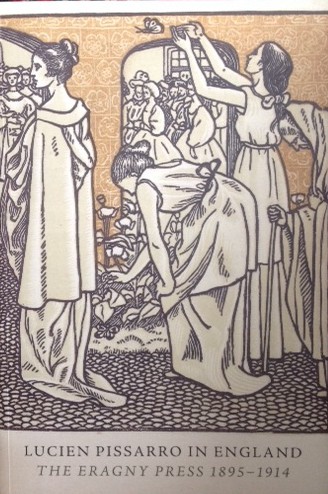Inspiring Older Readers
 posted on 12 Jun 2018
posted on 12 Jun 2018
Lucien Pissarro in England: The Eragny Press 1895 – 1914
Lucien was the rather troublesome eldest son of the great Impressionist, Camille Pissarro. When I say ‘troublesome’ what I really mean is that the older Pissarro just couldn’t see how his son was going to cut it in the art world and this caused him considerable concern. Lucien had aspirations as a landscape painter, wood engraver and print maker but it wasn’t until he came to settle in England in 1890 at the age of twenty seven that his future path seemed to open up for him.
In 1892 he married Esther Levi and a year later the couple had their only child. By this time he was living Essex and his art had fallen firmly under the influence of the Arts and Crafts Movement and especially the influence of the great illustrator, Walter Crane. It may well have been this influence that persuaded Lucien and Esther to set up their own printing and publishing concern in 1894 which they called The Eragny Press. Art and Antiques magazine described Eragny in this way:
“Of all the so-called private presses that flourished in England during the 1890s and up to World War I, Eragny (named for the town in Normandy where the Pissarro family lived) achieved the most harmonious union of typography and imagery.”
This book which was published by The Ashmolean Museum in 2011 contains three short but informative essays about the years of the Eragny Press from 1894 until its closure in 1914 and an extensive catalogue of the exhibition that the museum mounted in Oxford.
For me the stars of the show are the book designs that are beautifully reproduced here. Between them Lucien and Esther illustrated and produced 32 books and Jon Whiteley writing in his accompanying essay, The Art Of The Eragny Press, says of them:
"During the eighteen years between ‘The Queen of the Fishes’ and ‘Whym Chow’, Lucien and Esther had issued only thirty-two titles. They were hindered by setbacks and the constant threat of insolvency, but the list which they produced, small though it is, includes some of the finest work produced by the English private presses. There is not one Eregny book that does not have a discreet and distinctive charm and several are among the most delightful publications in the history of printing."
I think this is a generous but fair assessment of the examples contained in the book and anyone at all familiar with the printing conventions of the Arts and Crafts period will recognise the style – there’s a sort of blend of art nouveau, Pre-Raphaelite medievalism and more than a dash of William Morris that are skilfully blended into a pleasing whole.
Art and Antiques magazine can have the last word on the subject of this rather lovely production that can be picked up for not very much on the second hand market:
"The indefatigable Lucien designed his own font, called Brook, made the woodcuts and operated the printing press with his own hands, while struggling with ill health and lack of capital. Unfortunately, the Pissarros never achieved anything remotely resembling financial success and were only able to publish a relatively small number of titles, but Eragny earned a special place on the shelves of biblio-history."
Terry Potter
June 2018
( Click on any image below to view them in a slide show format )







